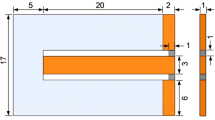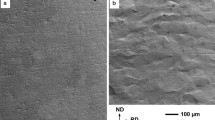Abstract
Orientation imaging microscopy was used to identify solidification microstructures and early stages of damage evolution in tin-silver eutectic solder joints on copper and nickel substrates after aging, creep, and thermomechanical fatigue. A visco-plastic self-consistent plasticity model was able to simulate texture changes when work hardening occurred at higher strain rates, but not with lower rates, where grain boundary sliding dominated the deformation and slip occurred predominantly on one or two slip systems that could be predicted using a Schmid (Sachs) analysis.
Similar content being viewed by others
References
J.G. Lee and K.N. Subramanian, “Microstructural Features Contributing to Enhanced Behaviour of Sn-Ag Based Solder Joints,” Soldering & Surface Mount Technology, 17 (1) (2005), pp. 33–39.
J.G. Lee and K.N. Subramanian, “Effect of Dwell Times on Thermomechanical Fatigue Behavior of Sn-Ag Based Solder Joints,” J. Electronic Materials, 32 (2003), pp. 523–530.
J.G. Lee et al., “Residual-Mechanical Behavior of Thermomechanically Fatigued Sn-Ag Based Solder Joints,” J. Electronic Materials, 31 (2002), pp. 946–952.
A.U. Telang et al., “Comparisons of Experimental and Computed Crystal Rotations Due to Slip in Crept and Thermomechanically Fatigued Dual Shear Eutectic Sn-Ag Solder Joints,” J. Electronic Materials, 32 (2003), pp. 1455–1462.
M. Fujiwara and T. Hirokawa, “The Strength of Main Obstacles to Dislocation Motion in White Tin Crystals,” J. Japan Inst. Metals, 51 (1987), pp. 830–838.
J.A. Rayne and B.S. Chandrasekhar, “Elastic Constant of Beta Tin from 42 K to 300 K,” Phys. Rev., 120 (1960), pp. 1658–1663.
D. Frear, H. Morgan, and J.H. Lau, editors, The Mechanics of Solder Alloy Interconnects (New York: Van Nostrand Reinhold, 1994).
J.E. Breen and J. Weertman, “Creep of Polycrystalline Tin,” J. Metals, 7 (1955), p. 1230.
J. Weertman and J.E. Breen, “Creep of Tin Single Crystals,” J. Appl. Phys., 27 (1956), p. 1189.
J. Weertman, “Compressional Creep of Tin Single Crystals,” J. Appl. Phys., 28 (1957), p. 196.
J. Weertman, “Creep of Indium, Lead, and Some of Their Alloys with Various Metals,” Trans. Amer. Inst. Min. Engrs., 218 (1960), p. 207.
R. Darveaux and K. Banerji, “Constitutive Relations for Tin-Based Solder Joints,” IEEE Trans. Components, Hybrids and Manuf. Tech., 15 (1992), pp. 1013–1024.
L.P. Lehman et al., “Growth of Sn and Intermetallic Compounds in Sn-Ag-Cu Solder Joints,” J. Electronic Materials, 33 (12) (2004), pp. 1429–1439.
D.W. Henderson et al., “The Microstructure of Sn in Near-Eutectic Sn-Ag-Cu Alloy Solder Joints and Its Role in Thermomechanical Fatigue,” J. Materials Research, 19 (2004), pp. 1608–1612.
A.U. Telang et al., “Grain Boundary Sliding on 7, 14, and 22° Special Boundaries during Thermomechanical Cycling in Dual-Shear Lap Lead-Free Solder Joint Specimens,” Materials Science and Engineering, in press.
A.U. Telang et al., “Orientation Imaging Studies of Sn-Based Electronic Solder Joints,” J. Materials Research, 17 (2002), pp. 2294–2306.
A.U. Telang and T.R. Bieler, “Characterization of Microstructure and Crystal Orientation of the Tin Phase in Single Shear Lap Sn-3.5Ag Solder Joint Specimens,” 52 (10) (2005), Scripta Materialia, pp. 1027–1031.
E.L. Maksimova, L.S. Shvindlerman, and B.B. Straumal, “Transformation of Sigma 17 Special Tilt Boundaries to General Boundaries in Tin,” Acta Metall., 36 (1988), pp. 1573–1583.
D.A. Molodov, B.B. Straumal, and L.S. Shvindlerman, “The Effect of Pressure on Migration of Tilt Grain Boundaries in Tin Bicrystals,” Scripta Metallurgica, 18 (1984), pp. 207–211.
H. Kokawa, T. Watanabe, and S. Karashima, “Sliding Behavior and Dislocation Structures in Aluminum Grain Boundaries,” Phil. Mag. A, 44 (1981), pp. 1239–1254.
L.S. Shvindlerman and B.B. Straumal, “Regions of Existence of Special and Non-Special Grain Boundaries,” Acta Metall., 33 (1985), pp. 1735–1749.
A.U. Telang et al., “Grain Boundary Character and Grain Growth in Bulk Tin and Bulk Lead-free Solder Alloys,” J. Electr. Mater., 33 (12) (2004), pp. 1412–1423.
A. Zamiri et al., unpublished research (2005).
Y.B. Park, D.N. Lee, and G. Gottstein, “A Model of the Development of Recrystallization Textures in Body Centered Cubic Metals,” Materials Science and Engineering A, 257 (1998), pp. 178–184.
A.U. Telang and T.R. Bieler, Solid State Phenomena, 105 (2005), pp. 219–226.
H. Rhee et al., “Mechanical Characterization of Sn-3.5Ag Solder Joints at Various Temperatures,” Soldering and Surface Mount Technology, 15 (3) (2003), pp. 21–26.
R.A. Lebensohn and C.N. Tomé, “A Self-Consistent Anisotropic Approach for the Simulation of Plastic Deformation and Texture Development of Polycrystals—Application to Zirconium Alloys,” Acta metal.mater., 41 (1993), pp. 2611–2624.
C.N. Tomé and R.A. Lebensohn, Manual for Code Visco-Plastic Self-Consistent (VPSC), Version 6 (Los Alamos, NM: Los Alamos National Laboratory, May 2003).
L.P. Lehman et al., “Microstructure and Damage Evolution in Sn-Ag-Cu Solder Joints,” 2005 Proceedings 55th Electronic Components and Technology Conference (2005) pp. 674–681.
Author information
Authors and Affiliations
Additional information
A.U. Telang (currently employed at Intel Corporation, Hillsboro, Oregon) completed his Ph.D. in 2004, with Associate Professor
Rights and permissions
About this article
Cite this article
Telang, A.U., Bieler, T.R. The orientation imaging microscopy of lead-free Sn-Ag solder joints. JOM 57, 44–49 (2005). https://doi.org/10.1007/s11837-005-0135-9
Issue Date:
DOI: https://doi.org/10.1007/s11837-005-0135-9




